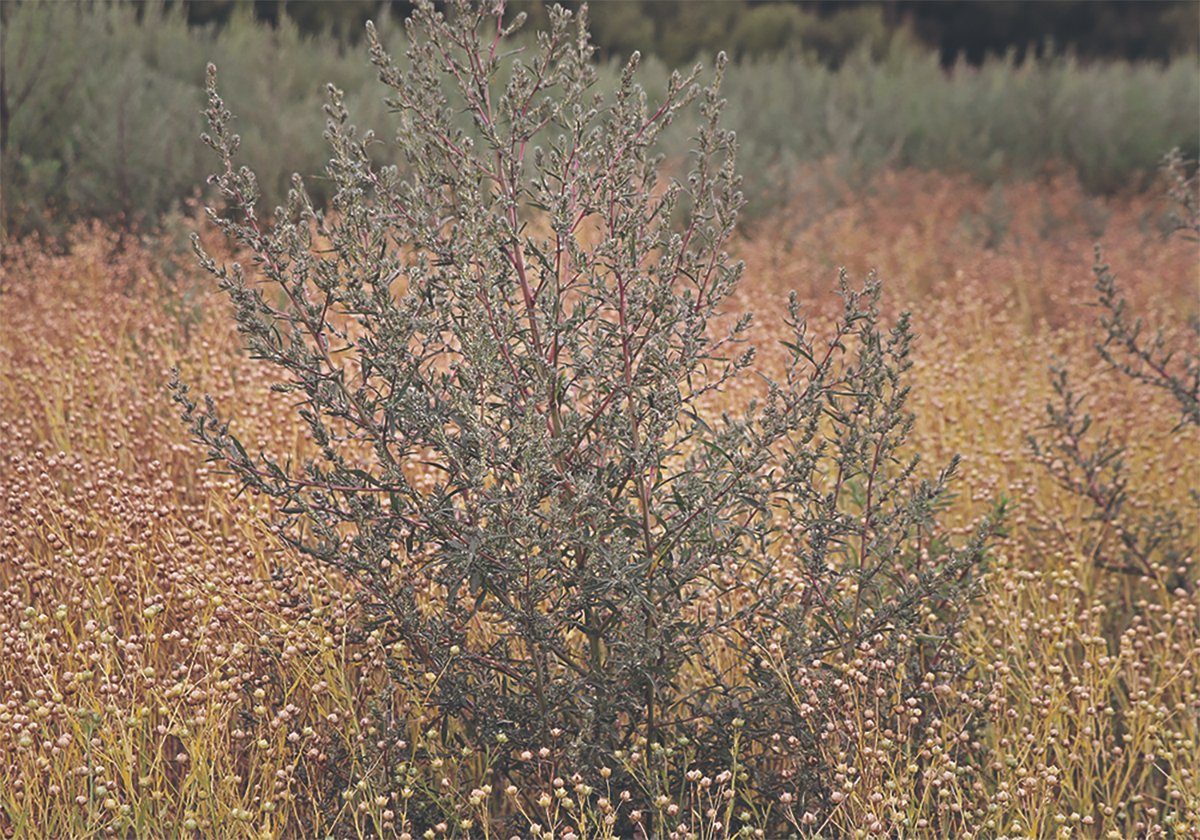Products and recipes to try
This column often receives information on new products and new cookbooks. This week I’ll share some of this information with you.
- The Moose Cookbook: Over 100 Ways To Cook Your Moose by Colonel Jack Koneazny. Published by General Store Publishing House, Burnstown, Ont. 1997 and sells at bookstores for $12.95.
Recipes include original choices as well as clever adaptations from the world’s great cuisines. The collection includes dozens of soups, sauces, glazes and marinades, and instructions for making sausage, corning moose meat and curing moose pastrami.
Read Also

Kochia has become a significant problem for Prairie farmers
As you travel through southern Saskatchewan and Alberta, particularly in areas challenged by dry growing conditions, the magnitude of the kochia problem is easy to see.
Koneazny, a retired U.S. army veteran and tree surgeon, and his wife Dottie, are authors of another cookbook and Jack is the food editor of Boating World.
The Koneaznys began experimenting, keeping notes and adapting methods and ingredients, and this collection is the result.
He says “moose meat is the best meat I have ever worked with. It’s lean, it’s tender and it’s tasty.”
- Skinny Feasts: Deceptively Rich Cooking The Low Fat Way by dee Hobsbawn-Smith. Published by Whitecap Books, Vancouver/ Toronto, 1997. Soft cover costs $20.
Skinny Feasts does away with the notion of “good food, bad food.” Instead, recipes combine small amounts of fattening ingredients with low-fat cooking techniques, thus reducing fat without losing taste. The trick is in the steaming, braising and poaching that replaces traditional cooking methods.
There are 240 pages of recipes for everyday dinners to festive celebrations. Along with each recipe the author provides information on its source, what it tastes like and foods to serve with it.
Dee Hobsbawn-Smith has worked alongside many of North America’s leading chefs. She is eager to share her passion for healthy food in her catering business, her teaching and in this, her first book. She lives in Calgary.
- More Splendid Desserts by Jennifer Eloff, published by Macmillan Canada, Toronto, 1997.
Several years ago, Emmie Oddie, in her column mentioned the first cookbook by Jennifer Eloff, Splendid Dessert. Now there is another book available, More Splendid Desserts, this time with both the nutritional analysis and Canadian Diabetes Association food choice symbols.
The recipes do not use sugar, but a substitute called Splenda Granular. Because her husband could not tolerate sugar, Eloff researched many of the low-calorie sweeteners on the market. She found Splenda was the only one suitable for baking. Because Splenda differs in density from sugar, it cannot be simply substituted for sugar in baked items. She experimented and went on to create a variety of delicious desserts that have the texture and taste of their calorie-rich alternatives, but with less fat and no sugar. She says her family and friends can’t tell the difference.
A signed personalized copy of More Splendid Desserts can be ordered from: Jennifer Eloff, Eureka Publishing, Box 2305, Station “M”, Calgary, Alta., T2P 2M6. Send $17.01 which includes GST, shipping and handling. The book is also available at bookstores.
- I Love Potato Cookbook by the families growing Alberta potatoes and Wendy Benson & Associates, Calgary. From the Potato Growers of Alberta, 1997.
This new cookbook brings the popular potato into the 1990s with ideas and recipes for low fat, quick cooking, new twists for this comfort food and basic potato preparation for those who haven’t spent too much time in the kitchen.
It contains 66 pages of every kind of potato dish you could imagine, from cheesy potato snacks to a cajun potato bake, crusty potato logs, beef and potato stir fry and chocolate tweed cake. Symbols mark recipes low in fat or quick to prepare.
Available by writing to: Potato Growers of Alberta, Suite 6, 1323 – 44 Avenue N.E., Calgary, Alta., T6E 6L5. Cost $12.
Marinades for tenderness
Marinate? Too late! In today’s time-crunched households, planning meals in advance is the exception rather than the rule. Studies show more than half of Canadians do not decide what’s for dinner until sometime during the day. That doesn’t leave time to marinate. This is regrettable as many flavorful, inexpensive cuts of meat can be tenderized in as little as six to eight hours in a marinade.
One solution is a new product that can tenderize in less than 30 minutes, the time it takes to prepare the vegetables. It comes in a variety of brand names including Beef Round Up Marinade, Magic Creations, Our Butcher’s Choice Steak and Kebabs Marinade. Watch for these marinating sachets, often offered free, wrapped with cuts of meat, or sold separately in some retail chains at the meat case.
Martha Carman, director of Protein Seasonings with Griffith Laboratories, is responsible for the development of many of these marinades. She says, “the active ingredients, bromelain, papain and ficin are naturally occurring proteases from pineapple, papaya and figs. Proteases are enzymes which break down the connective tissue in the meat, making less tender cuts more tender.”
The marinades are designed to enhance the natural flavor of meats without adding a strong competing flavor in its own right. Carman explains that this low flavor profile increases the marinade’s versatility. “You can use the marinade on steaks and then add your favorite seasoning rubs or barbecue sauces without any flavor competition. The marinade is also suitable for stir-fry strips where you will be adding distinctively different flavors to the wok.” By using this marinade on less expensive cuts, such as round or blade steak, you can get the tenderness of T-bone or rib without the cost.
Recipe requests
Dear TEAM: I am looking for a recipe for making fruit from vegetable marrow. My mother used to can them for winter and I would like to can some this year. – E.M.
Dear E.M.: We have not been able to locate this recipe. No doubt your mother made this fruit using what she had, and that likely didn’t include a recipe. Can any of our readers help us out?
Remember that a low acid food like vegetable marrow (and other vegetables) must be processed at a temperature of at least 240 F (116 C) to eliminate the risk of botulism. The only way to achieve this temperature is in a pressure canner.
Dear TEAM: Would anyone have a recipe for sour cucumber pickles? – A.M., Mission, B.C.
Dear A.M.: For most of us on the Prairies, pickling season has passed and we will need to file away this recipe until next year. In warmer climates like Mission, B.C., pickling may still be under way.
The following recipe is from the preservation booklet Home Canning Guide, published by Bern-ardin. As yet, I have not tried this recipe.
Sour cucumber pickles
5.5 lb. medium-sized 2.5 kg
cucumbers
8 cups cider vinegar 2 L
2 cups water 500 mL
1Ú2 cup pickling salt 125 mL
1Ú2 cup granulated 125 mL
sugar
1Ú2 cup white 125 mL
mustard seed
Fill boiling water canner with water. Wash cucumbers; pack into sterilized jars, leaving a one inch (two centimetre) headspace. Mix vinegar, water, salt, sugar and mustard seed. Bring to boiling point. Pour hot mixture over cucumbers, leaving a half inch (one cm) headspace. Clean jar rims. Centre snap lid on jar; apply screw band just until fingertip tight.
Place jar in canner; cover canner; return water to a boil; process 15 minutes. Remove jars. Cool 24 hours before checking the seals.
















